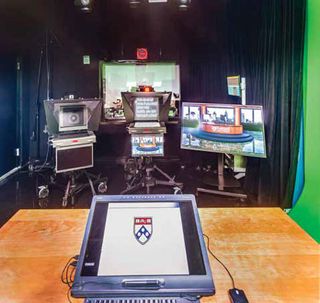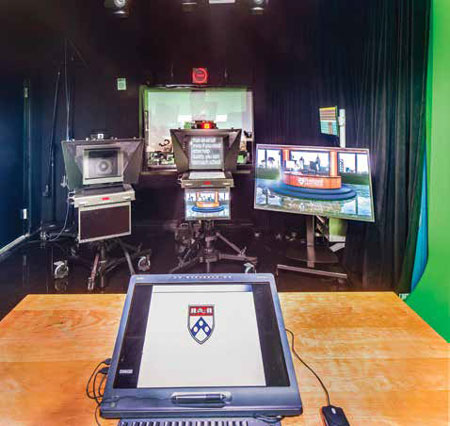The University of Pennsylvania’s Perelman School of Medicine, located in the heart of Philadelphia, is a major center of biomedical research and education. Also commonly known as Penn Medicine, the school recently built a state-of-the-art broadcast studio to produce massive online open courses (MOOCs), along with other training and demonstration videos for physicians and nurses.

UPenn’s Perelman School of Medicine’s new broadcast studio allows them to record course lectures, education and training videos, and more for the school’s vast online network. To ensure the studio was equipped with the best technologies, New Jersey-based integrator VCA was brought in to help design the AV system for the studio.
“It was about a $900,000 project. Our job was to take care of the control room, studio, lighting—everything was purpose-built for their needs,” said Charlie Ruban, VCA account manager.
Working closely with VCA was Charles Bears, UPenn’s director of media technology and production, who helped VCA fit the studio design to their needs.
“Our partnership was great,” said Bears. “VCA’s knowledge and expertise helped us transfer our concrete room into a design that’s suitable for us. The purpose of the studio was first to develop content for our open learning companies, and the second part was to have a broadcast studio, so doctors can come in and give us their expertise on a topic.”
VCA wanted to film in 1080p resolution, so they chose to include Sony broadcast cameras mounted on Vinten pedestals, AutoScript Epic prompters, Shure wireless microphones, TBC consoles, and an LED lighting grid and fixtures.
In the control room, a NewTek TriCaster 860 was installed, along with Sony Professional displays, SxS digital recorders, Evertz terminal equipment, and Tektronix signal measurement.
“Having the TriCaster allows us to build virtual sets in conjunction with the broadcast,” said Bears. “With our two-to-three-camera environment, we can cycle around the room and superimpose any background of our choice.”
“NewTek does a great job with green screens,” added Ruban. “They give us the ability to create an environment and perform in it.”
One of the other features in the new studio is a fiber matrix control room that is set up to allow connectivity throughout the school, bringing together what’s going on in the studio with conference rooms, lecture halls, and classrooms. “It gives us the ability to have a two-way interaction with the school,” Bears explained.
The original space wasn’t designed to be a studio, which created some significant challenges for VCA as they began designing. One of the biggest was acoustics, as the studio is surrounded by glass and overlooks an Amtrak train line.
“As the trains come through town, they’re blowing their horns, and you can hear (and feel) the trains running on the tracks,” said Ruban. “We had to build a room within a room so that it could have the proper heat and ventilation, but also create a good acoustic atmosphere.”
Since the studio’s completion, Bears said he’s very happy with the result.
“The studio is fully operational,” he said. “We’re already developing medical content for open-learning platforms, and we’ll be connected to our major networks at the end of the month. We’re already using the studio to develop training videos internally.”
Kelleigh Welch is managing editor of Systems Contractor News. Follow her on Twitter @kelleighwelch.










